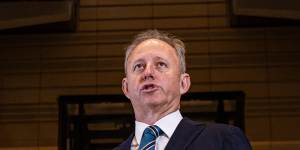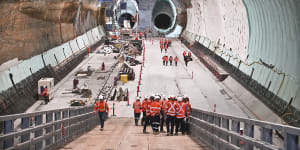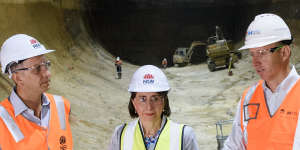As the new metro line opens under the heart of Sydney,we take a look at how it became a reality.See all19stories. On a Sunday in September 2019,NSW Transport chief Rodd Staples was sitting at a dining table in his Sutherland home when he got a phone call that instantly caused him alarm. “It was very stark,and I remember being really concerned about it because we obviously thought about all the possible things that could go wrong,” he recalls.
Sydney Metro executive Tim Parker was on the other end of the phone.
“He said,‘Rodd,I just want to let you know we’ve got a problem. It’s not really a problem,but we’ve got these bubbles in the harbour above where the tunnelling is going on’,” Staples explains. “I said to him,‘wow Tim,that really sounds like a problem’.”

Giant bubbles rise to the water’s surface directly above a giant machine tunnelling under Sydney Harbour in September 2019.
The bubbles were rising to the water’s surface directly above a giant tunnelling machine which was carving through rock and sediment beneath Sydney Harbour in an around-the-clock operation. With a small crew on board,the 170-metre-long machine was in the midst of one of the riskiest parts of the$21 billion Metro City and Southwest project,digging twin 800-metre-long rail tunnels under the harbour between Blues Point and Barangaroo.
The bubbles immediately raised fears that one of the tunnels had been damaged,and possibly breached. “The first reaction in my mind when I heard that there are bubbles was,‘wow,is there water getting into the tunnel and might it be about to collapse’?” Staples recalls.
With anxiety levels rising,senior transport officials and tunnelling experts held a series of teleconferences as they grappled with the cause of the bubbles. Their worst fears faded as reports quickly came in from the project site that the tunnel was intact. And within 24 hours,experts were confident that in fact vibrations from the boring machine had disturbed air pockets within sediment on the harbour floor.
Yet,it was a reminder of the project’s complexity and the challenges that transport officials and tunnelling contractors were wrestling with every day.
“Certainly,that was a more anxious day,” Staples says. “But I was anxious every day while the build was going on because you had thousands of people out at the coalface building things. You’re always worried within the scale of what you’re doing that something could go wrong.”

“Metro Man”:Rodd Staples,who is widely regarded as the main architect of Sydney’s metro rail network,at the new Martin Place station.Credit:Nick Moir
Dubbed “Metro Man”,Staples is widely credited as the architect of Sydney’s new rail network,earning comparisons with NSW’s most famous engineer,John Bradfield. Staples’ involvement in planning and steering metro rail projects span Labor and Coalition state governments,dating as far back as 2007,shortly afterDavid Richmond,who played a central role in running the 2000 Sydney Olympics,put the idea of a metro system on the table.
“Rodd Staples was the John Bradfield of our time. He is a true visionary,” says Rob Stokes,a former senior minister in the previous Coalition state government. “He quietly got on with it,and took the opportunity Gladys[Berejiklian] had given him,and he ran with it.”
When Berejiklian gave Staples the job ofleading the north-west rail link project in April 2011,it quickly became obvious to him that there was nowhere for the double-decker trains they planned to use on that line to go. The lines it would feed into – the north shore and main north line via Strathfield – were nearly chock-full of trains. “You’d essentially choke the network on the day it opened,” Staples says. “You might have opened a brand new railway and been able to run two to four trains an hour on it.”
It triggered a major rethink that culminated in a decision in 2012 to build the north-west rail link as a line for single-deck driverless trains,as well as setting in motion plans to extend the metro system under central Sydney.
More than a decade later,construction of the Metro City and Southwest line under the heart of Sydney was a constant balancing act,involving calculated decisions about how far the engineering envelope could be pushed.
Under the early plans,twin tunnels under the harbour were to be up to 15 metres deeper to avoid softer ground conditions closer to the harbour floor.
Yet,it posed a dilemma for a planned station at North Sydney. A deep tunnel under the harbour meant the station there would have to be more than 50 metres below the surface at North Sydney so that trains could climb the line’s gradient from the deepest part of the tunnel to the north shore. A station that deep would also cost more,forcing Staples and his team to consider lift-only access to the North Sydney stop because taking escalators from platforms to streets above would be a long trip for commuters.
They eventually settled on tunnelling at shallower depths under the harbour,which avoided an ultra-deepstation at North Sydney but exposed the project to poorer ground conditions to tunnel through under the harbour.

The giant cavern excavated under North Sydney for the Victoria Cross metro station.Credit:Ben Rushton
“What came with that was as we tunnelled under the harbour,every metre we were worried about water ingress into the tunnel,” Staples says. “Most of the tunnelling that’s done in Sydney is like carving a hole out of Swiss cheese whereas going through the harbour is more like tunnelling through yoghurt.”
South of the harbour,they had to thread the eye of a needle as they tunnelled around deep building basements beneath the CBD,and over and around existing infrastructure such as theCross City Tunnel,and the Eastern Suburbs and City Circle rail lines.
“Weaving the alignment through the city was very challenging. We basically surveyed every building basement,every car park and then had to thread the needle of the tunnels through there,” Staples recalls. “There was a lot of concern about how we would build a railway through the city.”

Rodd Staples,right,inspects the site of a station at Barangaroo in March 2019 with then transport minister Andrew Constance and premier Gladys Berejiklian.Credit:James Brickwood
In the early days of the projects,Staples looked closely at the way Bradfield planned transport links in the city early last century,and built the Harbour Bridge and City Circle rail line in the central city.
“He basically did open-heart surgery on the city. He just dug it up. He dug up Wynyard Park;he dug up Hyde Park;he dug up streets. He had the luxury of the city not being as busy whereas we did keyhole surgery,” Staples says.
The keyhole surgery the modern-day engineers had to embark on involved excavating within 10 metres of the footings of Sydney Tower,the city’s tallest structure also known as Centrepoint Tower. Under Martin Place,tunnelling machines came within metres of the Eastern Suburbs railway tunnels. The work required pinpoint accuracy with the tunnelling machines,and constant checking that they were in the right spots.
The early plans did not include stations at the northern edge of the CBD or between Central Station and Sydenham due largely to the cost. But by 2015,the Baird government decided to add stations atBarangaroo andWaterloo.
“Getting Barangaroo and Waterloo added enormous value to the benefit of the project,” Staples says. “We thought about another station between Waterloo and Sydenham,but we weren’t really able to identify a location that made sense to build a town centre around it within the existing urban fabric between the city and the airport.”
More than 90 years ago,Staples’ grandfather toiled as a riveter on the Harbour Bridge’s southern arch. The Great Depression was impoverishing people,and his grandfather’s job building the bridge put food on the family table.
Later,books about the famed coathanger lined a shelf in the loungeroom of the family’s Redfern home. “I actually remember reading through a lot of the history of the way the bridge came together,and then reflected on how that played with the rail network that Bradfield actually did build,” Staples says.
In December 2019,Staples walked the entire length of the rail tunnels under the harbour shortly after they were completed,reflecting on his grandfather’s work on the bridge last century.
“It was nice to walk through it and see how dry it was,and still is,” Staples quips,with a laugh. “We can’t imagine what Sydney is like now without the harbour bridge. I’d say in 10 to 20 years time people will look back and say,‘I can’t imagine how Sydney would get by without the Metro’.”
Start the day with a summary of the day’s most important and interesting stories,analysis and insights. Sign up for our Morning Edition newsletter.